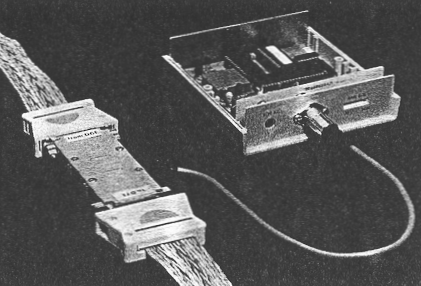|
DataCast
Datacast is the use of lines in the vertical blanking intervals to
transmit a data service for commercial purposes. The ordinary television viewer is
generally oblivious to the existence of the service.
The Datacast service is offered by the British Broadcasting Corporation. The first
equipment designed to offer the facility commercially was activated on 10-March-1986 at
the BBC Television centre.
In the original teletext specification, teletext data lines with row addresses in the
region 24 - 31 were to be ignored by ordinary teletext decoders. This was later changed as
row address 24 and 25 were reserved for use with the teletext page.
The Datacast line is different is structure from the ordinary teletext line. It also
differs from ordinary teletext in that the information in a datacast line can be
interpreted without reference to other lines. The ordinary teletext structure is page
based. The structure of a datacast line is shown in the diagram below. The initial section
of the line is similar to the ordinary teletext line. The subsequent structure is
different from that of the ordinary teletext line.
| Bytes in the DataCast Teletext Line |
2 |
1 |
2 |
1 |
1 |
Upto
6 |
1 |
1 |
1 |
28
to 36 |
2 |
CRI |
Framing Code |
Data Channel |
Format Type Byte |
Packet Address Length |
Packet Address Bytes |
Packet Repeat Indicator |
Packet Continuity Indicator |
Data Length Byte |
User Data |
CRC |
|
|
|
|
|
|
|
|
|
|
|
The Datacast line structure is different from the ordinary teletext line structure in that
it is not page dependent. This means that only changing data needs to be sent to the
receiving decoder. The background image could be generated by a computer program resident
in the receiving decoder. This improves the overall security of the system.
The clock run in and framing code are identical to ordinary teletext line parameters. This
is to enable the use of standard teletext circuitry in the Datacast decoders. The third
and fourth byte, used for magazine and row address in ordinary teletext (MRAG), are used
for data channel group identification and independent line identification. The third byte
is used to identify the originator of the Datacast line. The fourth byte identifies the
line as an independent line by carrying the data 1111. The data bits are Hamming system
coded to form the byte.
Format Type Byte ( Byte 5 )
The fifth byte carries the format control information. Again only four of the bits are
data bits, the rest are Hamming System coding bits. The first bit is zero if the line is
Datacast format. The second bit is high if the Packet Repeat Indicator byte is used later.
The third bit is high if the Packet Continuity Indicator index byte is used later. The
fourth bit is high if the Data Length byte is used later.
Packet Address Length ( Byte 6 )
The first three bits of the data in this byte indicate how many of the following address
bytes relate to the packet address. Again Hamming System coding is used for error
correction.
Packet Address Bytes ( Bytes 7, 8, 9, 10, 11, 12 )
These bytes define the address of the packet, defined by PAL. These bytes are Hamming
protected and as a result, the maximum is 6 bytes, giving an address width of 24 bits.
Packet Repeat Indicator Byte ( Byte 13 )
This byte is present only if the PRI bit is high in the Format Type byte. Its basic
purpose is to allow a packet of information to be sent once every hour or every day. The
first four bits are set to 0 when a new packet is sent and is incremented modulo-16 once
repeated. The last bit is low if no more repeats of the packet will be sent.
Packet Continuity Indicator Byte ( Byte 14 )
This byte is present only if the PCI bit is high in the Format Type byte. It is an eight
bit number. If the same packet is being repeated it does not change. It is only
incremented modulo-256 on receiving a new packet.
Data Length Byte ( Byte 15 )
This byte is present only if the DL bit is high in the Format Type byte. The first six
bits determine how many of the subsequent bytes are data that the user can access. the
main use of this byte is transmission economy. In this way, a packet does not need to be
completely filled for transmission.
User Data Byte Group
There are between 28 and 36 data bytes per packet. This information can be encrypted for
security purposes. Due to the data intensive applications of DataCast, it is not
unthinkable that compression techniques would be used on the data.
Cyclic Redundancy Check
The last two bytes of each Datacast packet are used for Cyclic Redundancy Checking. This
is a very good method of discovering errors in transmitted data.
The Security Of The Datacasting System
The Datacasting system is temporarily secure. The main reason why the system has not been
hacked to date is the specialised nature of the information carried. It is also carried in
a non-standard format. If there is an adequate financial incentive for the system to be
hacked then it will be hacked.
The technology of Datacasting is primarily that of teletext. Therefore the present
teletext circuitry could be adapted to use as Datacast decoders. The BBC carried out much
of the development of the system using the BBC microcomputer and its teletext receiver.
The Design & Equipment Department of the BBC developed a design for a Datacasting
decoder that is available under licence to manufacturers.

|
